June marked the 25th Anniversary of Gramercy! Thank you to our valued investors, trusted business partners and team members without whom this milestone could not have been reached. We are excited for the opportunities we see ahead, and look forward to continuing to deliver upon our mission to have a positive impact on the well-being of our clients, portfolio investments (and their communities) and our team members.
Contents
Market Overview
Macro Review
ADP is always a poor predictor of Non-Farm Payrolls. A softer ADP and weaker JOLTS report had shifted the narrative to the possibility of higher unemployment. The NFP reading was 199k and comfortably beat expectations. Unemployment fell to 3.7% from 3.9% and re-calibrated the probability of a soft landing, or indeed, a no landing scenario. This was combined with a strong ISM Services PMI where prices paid were notably high. That said, the Atlanta GDPNow did drop by a large 1.3ppts to 1.2% in 4Q. Elsewhere, the Bank of Japan’s normalization of monetary policy is a real risk. Exiting the Central Bank’s negative interest rate policy (NIRP) is highly anticipated and reflected in the strength in JPY over the week. We also witnessed a brief flash-crash in crude oil, although the commodity quickly rebounded into the end of the week. Oil is some 22% lower since the September peak, but Saudi Arabia did state that OPEC+ oil production cuts can “absolutely” continue past the first quarter if needed. China also remained under pressure as Moody’s cut the credit outlook to negative on rising local government debt. The rating was affirmed at A1 having last been downgraded from Aa3 in 2017. Moody’s expects China’s GDP growth to be 4% in 2024 and 2025, relative to the government’s 5% target. Finally, U.S. support for Ukraine waned as Republican Senators blocked $60bn of aid and President Zelensky was increasingly criticized by the Mayor of Kyiv (Vitali Klitschko).
EM Credit Update
Emerging markets sovereign credit (cash bonds) ended the week up 1.3% with credit spreads 12bps tighter. U.S. Treasury yields increased 4-14bps in the front-end and belly, but rallied 6bps in the long-end. Sovereign outperformers were Ukraine, Gabon and Senegal, while Croatia, Mexico and China underperformed.
The Week Ahead
Next week will feature the FOMC, the ECB and the BOE with the final interest rate decisions of the year. We can probably expect all three to hold policy rates unchanged. The main EM events center around Javier Milei’s inauguration as Argentina’s President, just as Egypt hold presidential elections. EM interest rate decisions are due out of Brazil (12.25%), Mexico (11.25%), Peru (7.0%), Philippines (6.5%), Russia (15.0%), Taiwan (1.875%) and Ukraine (16.0%). In light of the political events, we can probably expect some focus on Argentine inflation given that expectations are as high as 154%, followed by other releases from the Czech Republic, South Africa, Nigeria, Poland and Romania.
Highlights from emerging markets discussed below: Venezuela claims an oil-rich Guyana region in a referendum marked by low turnout and Suriname completes sovereign debt restructuring.
Fixed Income
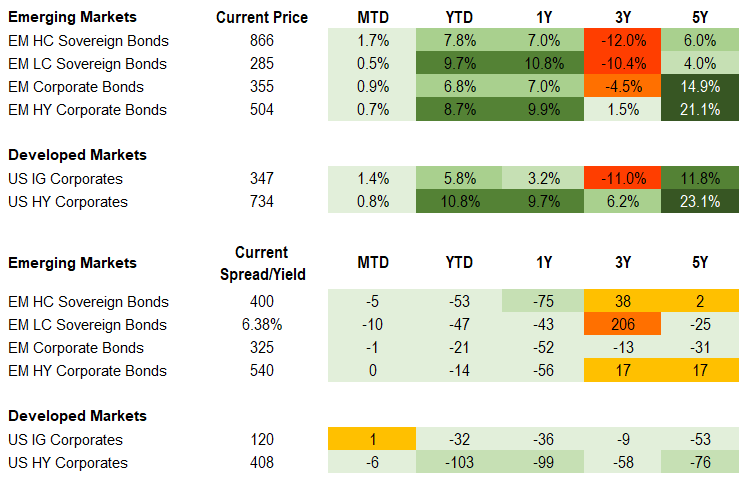
Equities
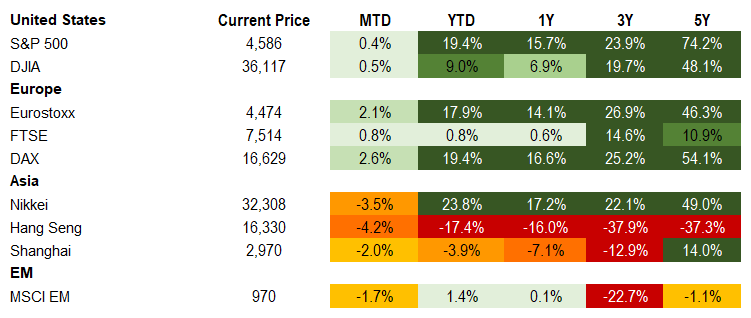
Commodities

Source for data tables: Bloomberg, JPMorgan, Gramercy. EM Fixed Income is represented by the following JPMorgan Indicies: EMBI Global, GBI-EM Global Diversified, CEMBI Broad Diversified and CEMBI Broad High Yield. DM Fixed Income is represented by the JPMorgan JULI Total Return Index and Domestic High Yield Index. Fixed Income, Equity and Commodity data is as of December 8, 2023 (mid-afternoon).
Emerging Markets Weekly Highlights
Venezuela claims an oil-rich Guyana region in a referendum marked by low turnout
Event: On Sunday, December 4th, the Venezuelan government held a national referendum asking voters to support the country’s long-standing (since the end of the 19th century) territorial claim over the Essequibo region in neighboring Guyana. According to the authorities, all five referendum questions were approved overwhelmingly. However, there has been significant uncertainty around turnout, with some reports suggesting that it might have been as low as 10% of eligible voters.
Gramercy Commentary: Essequibo is a sparsely populated area neighboring Venezuela and Brazil that makes up around two-thirds of Guyana’s territory. In 2015 there was a massive offshore oil discovery in waters adjacent to the region that has driven Guyana’s tiny economy to quadruple in terms of nominal GDP to an estimated $16bn in 2023 from around $4bn in 2015. Despite Essequibo’s attractive natural resources endowment and Venezuelan President Nicolas Maduro’s aggressive rhetoric since the referendum, we believe that a military escalation scenario carries a low probability due to various factors. These include logistical, political, and economic obstacles to a Venezuelan military incursion into Guyana as well as diplomatic pressure by stakeholders such as the U.S., Brazil, and China. We are of the view that an important objective of the government’s decision to call for the referendum was to score domestic political points ahead of critically important elections next year on an issue that most Venezuelans would be inclined to support. However, the low turnout highlights the challenges that Maduro’s regime is facing ahead of the vote, which is expected to take place in late 2024. The government’s approach to conducting the vote as well as its outcome will shape Venezuela’s potential re-integration within the international community.
Suriname completes sovereign debt restructuring
Event: This week, the government of Suriname formally completed its sovereign debt restructuring process with both official and private sector creditors. The defaulted 2023 and 2026 securities were exchanged for a new $660m 7.95% 2033 Eurobond and a value recovery instrument (VRI) that could pay investors in the event oil production from a large offshore field (Block 58) becomes commercially viable.
Gramercy Commentary: In a scenario of commercial oil production (projected within a 5-year time horizon), Suriname’s government will receive a 6.25% royalty fee on all revenues from Block 58. The royalty for the budget will be based on revenue, not profit, and the authorities have committed to allocate 30% of all Block 58 royalties in excess of the first $100m to an account dedicated to repaying the VRI. The viability of commercial oil production from Suriname’s offshore field remains uncertain, but if/when it materializes, the VRI seems to offer significant upside, in our view. In terms of Suriname’s sovereign credit profile, it is recovering from acute mismanagement under the previous administration that brought debt/GDP close to 150% in 2020, from 25% in 2014 when the country approached international capital markets for the first time. Under an IMF program, the authorities are targeting an ambitious fiscal adjustment and bringing debt/GDP below 100%, anchored by 3.5% of GDP primary surplus in 2024-25. This will require significant political willpower to hold the course ahead of elections in May 2025 and would also hinge on a favorable global commodity price environment.
Emerging Markets Technicals
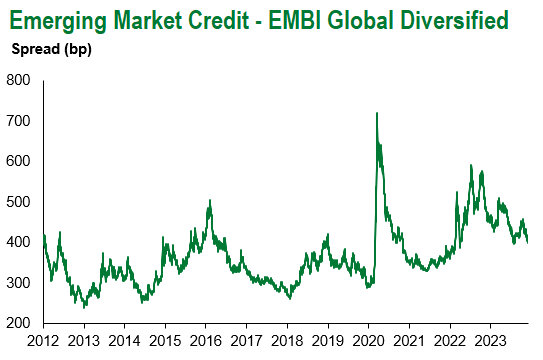
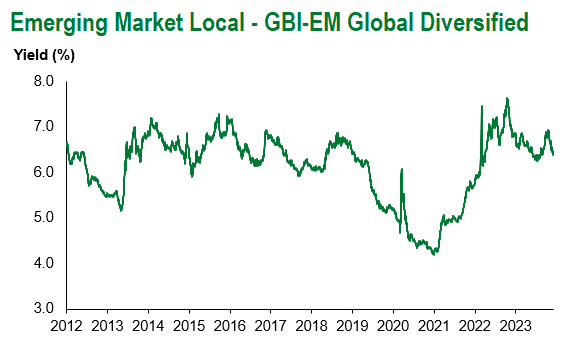
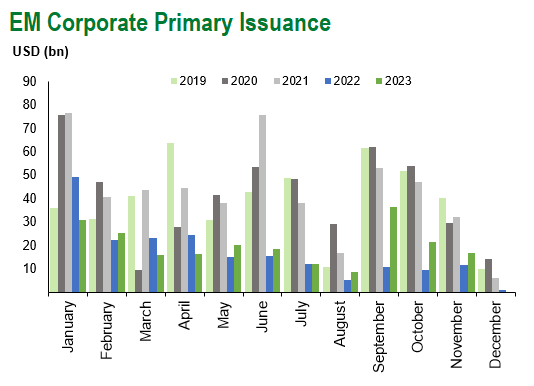
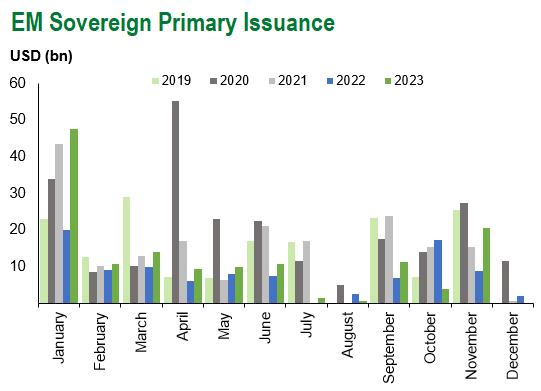
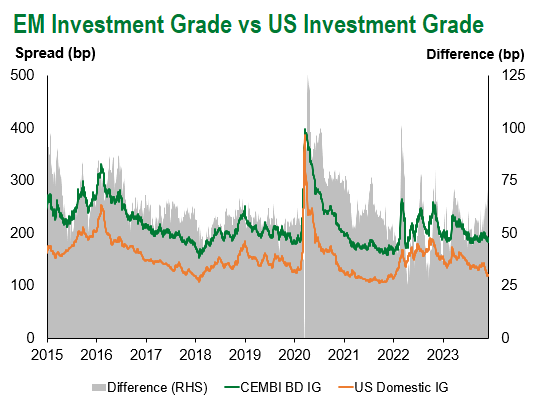
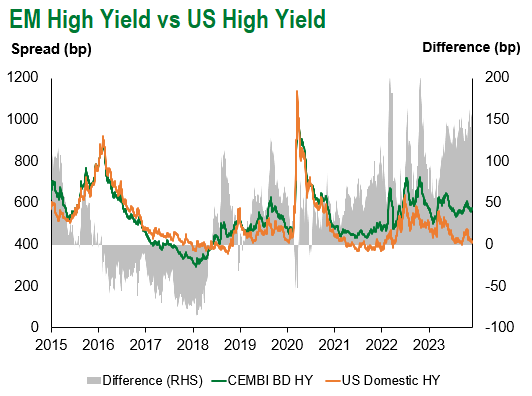
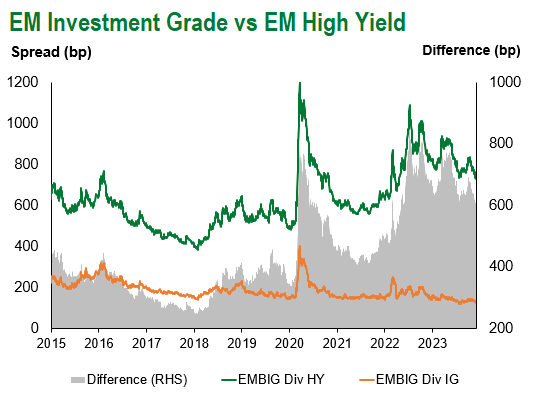
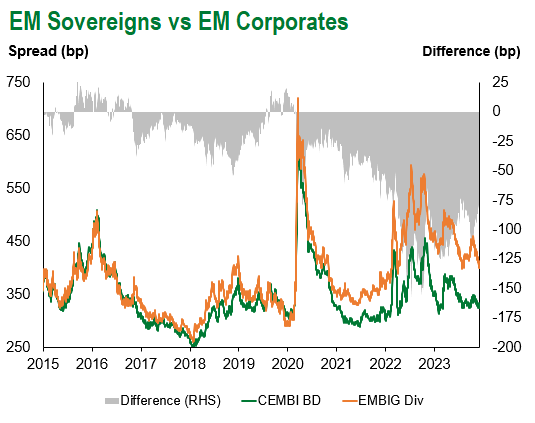
Emerging Markets Flows
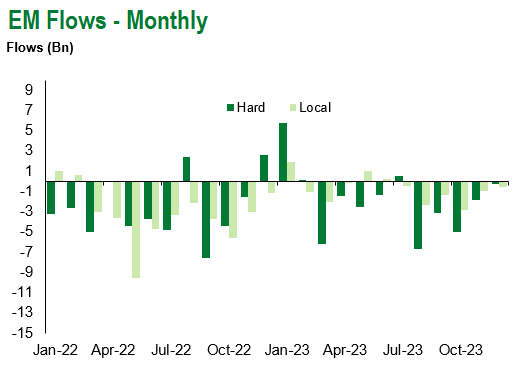
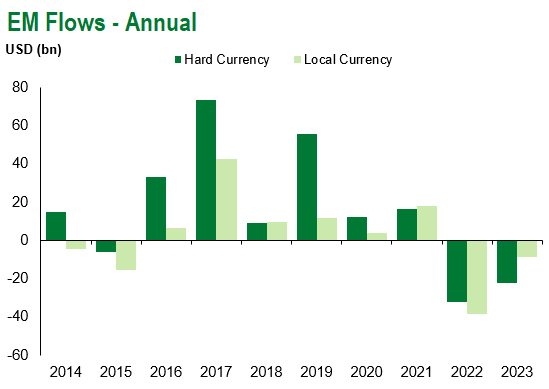
Source for graphs: Bloomberg, JPMorgan, Gramercy. As of December 8, 2023.
For questions, please contact:
Kathryn Exum, CFA ESG, Director, Co-Head of Sovereign Research, [email protected]
Petar Atanasov, Director, Co-Head of Sovereign Research, [email protected]
James Barry, Director, Deputy Portfolio Manager, [email protected]
This document is for informational purposes only. The information presented is not intended to be relied upon as a forecast, research or investment advice, and is not a recommendation, offer or solicitation to buy or sell any securities or to adopt any investment strategy. Gramercy may have current investment positions in the securities or sovereigns mentioned above. The information and opinions contained in this paper are as of the date of initial publication, derived from proprietary and nonproprietary sources deemed by Gramercy to be reliable, are not necessarily all-inclusive and are not guaranteed as to accuracy. This paper may contain “forward-looking” information that is not purely historical in nature. Such information may include, among other things, projections and forecasts. There is no guarantee that any forecasts made will come to pass. Reliance upon information in this paper is at the sole discretion of the reader. You should not rely on this presentation as the basis upon which to make an investment decision. Investment involves risk. There can be no assurance that investment objectives will be achieved. Investors must be prepared to bear the risk of a total loss of their investment. These risks are often heightened for investments in emerging/developing markets or smaller capital markets. International investing involves risks, including risks related to foreign currency, limited liquidity, less government regulation, and the possibility of substantial volatility due to adverse political, economic or other developments. References to any indices are for informational and general comparative purposes only. The performance data of various indices mentioned in this update are updated and released on a periodic basis before finalization. The performance data of various indices presented herein was current as of the date of the presentation. Please refer to data returns of the separate indices if you desire additional or updated information. Indices are unmanaged, and their performance results do not reflect the impact of fees, expenses, or taxes that may be incurred through an investment with Gramercy. Returns for indices assume dividend reinvestment. An investment cannot be made directly in an index. Accordingly, comparing results shown to those of such indices may be of limited use. The information provided herein is neither tax nor legal advice. Investors should speak to their tax professional for specific information regarding their tax situation.
